Sustainable Impact of Coarse Aggregate Crushing Waste (CACW) in Decreasing Carbon Footprint and Enhancing Geotechnical Properties of Silty Sand Soil
Abstract
:1. Introduction
2. Research Methodology
3. Experimental Work
3.1. Materials
3.2. Soil Characterization
3.3. Tests and Methods
3.3.1. Modified Proctor Compaction Test
3.3.2. Ultrasonic Pulse Velocity (UPV)
3.3.3. Unconfined Compressive Strength (UCS)
3.3.4. California Bearing Ratio (CBR) Test
4. Results and Discussion
4.1. Characterization of Soil and Stabilizer
4.1.1. Composition of CACW
4.1.2. Grain Size Distribution of Soil and CACW
4.1.3. CAWA as a Sustainable Material
4.2. Effect of CAWA on the Geotechnical Properties
4.2.1. Modified Proctor Compaction Test Results
4.2.2. Ultrasonic Pulse Velocity (UPV)
4.2.3. Results of California Bearing Ratio (CBR) Tests
4.2.4. Results of Unconfined Compression Strength Tests
4.3. Developed Research Methodology
- Introducing the CACW additive with the optimum percentage of CACW, i.e., 10%, that shows the highest values of UPV, CBR, and UCS in the dry silty sand soil.
- Adding the corresponding optimum water content (9.2%) and operating the mixer such that a CACW-soil mix forms.
- Introducing the Portland cement (2%) into the mixer and operating the mixer such that the cement-CACW stabilized soil forms.
- Constructing specimens for durability tests and microscopic investigation
- Comparing the results with the rigid and flexible pavement layer structure requirements and making a decision.
5. Durability Tests (Wetting and Drying)
5.1. Standard Durability Test [42]
- (1)
- Change of Volume (Vc):
- (2)
- Weight loss (Wl):
5.2. Durability Using Slake Test
5.3. Durability Test Results
5.4. Microscopic Investigation
5.5. Environmental Impact Evaluation
- Dynamic studies using CACW-stabilized soil can be used to investigate future rail and road applications.
- It is possible to test the stability of embankments and the endurance of highways built with soils treated with CACW.
- It is planned to test the results obtained from this work in future projects operated by the city authorities.
6. Conclusions and Recommendations for Future Work
- The improvement in the corresponding maximum dry density and shear strength causes an increase in soaked CBR values.
- Adding a small amount of additive (10%) to CACW improves the engineering properties of silty sand soils. This addition causes a net reduction in pore volume, aids in the quick development of dense mixes, and significantly increases compressive strength.
- The test findings showed that the optimum dosage is 10% CACW with 2% cement, raising the undrained shear strength of silty sand soil by 323%, CBR by 286%, and P-wave by 180%.
- The durability tests reveal that soil containing 10% CACW and 2% cement satisfies the specifications and stays within the 14% weight loss limit imposed by the Portland Cement Association (PCA).
- For subgrade and subbase layers, only silty sand soil stabilized with 10% CACW and 2% cement is suitable, in accordance with the durability findings and strength criteria. The other, on the other hand, is applicable to other field activities, such as enhancing the carrying capacity of sandy marl soil on pavements and low to moderately high-rise buildings.
- The microscopic investigation results confirmed the outcomes obtained by macro tests.
- This study clarifies the long-term effects of CACW on improving the engineering properties of silty sand soil in the Najran Region of the Kingdom of Saudi Arabia and other comparable soils globally. The general implications of this research and its prospective benefits are those for improving the geotechnical qualities of silty sand soils for road pavement applications and enhancing the bearing capacity under foundations and embankments.
- The authors recommend addressing the effects of adding CACW to other kinds of soil, such as clayey soils, which are distributed over large areas of Najran city as well as many other places overall in the Kingdom of Saudi Arabia.
Author Contributions
Funding
Data Availability Statement
Acknowledgments
Conflicts of Interest
References
- Abdullah, G.M.; Wahhab, H.I.A.-A. Evaluation of foamed sulfur asphalt stabilized soils for road applications. Constr. Build. Mater. 2015, 88, 149–158. [Google Scholar] [CrossRef]
- Abdullah, G.M.S.; Al-Abdul Wahhab, H.I. Stabilisation of soils with emulsified sulphur asphalt for road applications. Road Mater. Pavement Des. 2019, 20, 1228–1242. [Google Scholar] [CrossRef]
- Abdullah, G.M.S. Performance of Enhanced Problematic Soils in Roads Pavement Structure: Numerical Simulation and Laboratory Study. Sustainability 2023, 15, 2595. [Google Scholar] [CrossRef]
- Abdullah, G.M.S.; Abd El Aal, A. Assessment of the reuse of Covid-19 healthy personal protective materials in enhancing geotechnical properties of Najran’s soil for road construction: Numerical and experimental study. J. Clean. Prod. 2021, 320, 128772. [Google Scholar] [CrossRef]
- Abdullah, G.M. Using Plaxis 2D finite element modeling to assess bearing capacity of Sultana’s soil in Najran Region, Kingdom of Saudi Arabia. Mater. Today Proc. 2021, 49, 2679–2687. [Google Scholar] [CrossRef]
- Abdullah, G. Stabilization of Eastern Saudi Soils Using Heavy Fuel Oil Fly Ash and Cement Kiln Dust. Master’s Thesis, King Fahd University of Petroleum & Minerals, Dhahran, Saudi Arabia, 2009. [Google Scholar]
- Abdullah, G. Modeling the Behavior of Sulfur Modified Foamed and Emulsified Asphalt Soils Mixes for Local Road Applications. Ph.D. Thesis, King Fahd University of Petroleum & Minerals, Dhahran, Saudi Arabia, 2014. [Google Scholar]
- Ashfaq, M.; Heera Lal, M.; Moghal, A.A.B. Static and Dynamic Leaching Studies on Coal Gangue. In Sustainable Environmental Geotechnics; Reddy, K.R., Agnihotri, A.K., Yukselen-Aksoy, Y., Dubey, B.K., Bansal, A., Eds.; Lecture Notes in Civil Engineering; Springer International Publishing: Cham, Switzerland, 2020; pp. 261–270. [Google Scholar]
- Moghal, A.A.B.; Lateef, M.A.; Mohammed, S.A.S.; Lemboye, K.; C. S. Chittoori, B.; Almajed, A. Efficacy of Enzymatically Induced Calcium Carbonate Precipitation in the Retention of Heavy Metal Ions. Sustainability 2020, 12, 7019. [Google Scholar] [CrossRef]
- Putra, H.; Yasuhara, H.; Kinoshita, N.; Hirata, A. Optimization of Enzyme-Mediated Calcite Precipitation as a Soil-Improvement Technique: The Effect of Aragonite and Gypsum on the Mechanical Properties of Treated Sand. Crystals 2017, 7, 59. [Google Scholar] [CrossRef]
- Amulya, G.; Moghal, A.A.B.; Almajed, A. A State-of-the-Art Review on Suitability of Granite Dust as a Sustainable Additive for Geotechnical Applications. Crystals 2021, 11, 1526. [Google Scholar] [CrossRef]
- Mohamedsalih, M.A.; El Aal, A.K.A.; Radwan, A.E.; Abdullah, G.M.S.; Al Saiari, M. Feasibility of Najran rocks crushing waste as manufactured sand in the sustainable concrete industry in the Kingdom of Saudi Arabia. Int. J. Geotech. Eng. 2023, 17. [Google Scholar] [CrossRef]
- Suits, L.; Sheahan, T.; Soosan, T.; Sridharan, A.; Jose, B.; Abraham, B. Utilization of quarry dust to improve the geotechnicalproperties of soils in highway construction. Geotech. Test. J. 2005, 28, 11768. [Google Scholar] [CrossRef]
- Sridharan, A.; Soosan, T.G.; Jose, B.T.; Abraham, B.M. Shear strength studies on soil-quarry dust mixtures. Geotech. Geol. Eng. 2006, 24, 1163–1179. [Google Scholar] [CrossRef]
- Birch, W.; Datson, H. Reducing the Environmental Effects of Aggregate Quarrying: Dust, Noise & Vibration. 2008. Available online: https://miningandblasting.files.wordpress.com/2009/09/blast_dust_and_noise_control.pdf (accessed on 5 November 2021).
- Saghafi, B.; Al Nageim, H.; Atherton, W. Mechanical behavior of a new base material containing high volumes of limestone waste dust, PFA, and APC residues. J. Mater. Civ. Eng. 2013, 25, 450–461. [Google Scholar] [CrossRef]
- Tayeh, B.A.; Akeed, M.H.; Qaidi, S.; Abu Bakar, B. Influence of sand grain size distribution and supplementary cementitious materials on the compressive strength of ultrahigh-performance concrete. Case Stud. Constr. Mater. 2022, 17, e01495. [Google Scholar] [CrossRef]
- Kumar, D.S.; Hudson, W.R. Use of Quarry Fines for Engineering and Environmental Applications. 1992. Available online: https://library.ctr.utexas.edu/digitized/iacreports/1992_specrsrch_natlstoneassoc.pdf (accessed on 1 October 2021).
- Kumrawat, N.; Ahirwar, S.K. Performance analysis of black cotton soil treated with calcium carbide residue and stone dust. Int. J. Eng. Res. Sci. Technol. 2014, 3, 202–209. Available online: http://www.ijerst.com/currentissue.php (accessed on 15 July 2021).
- Antonov, G.I.; Nedosvitii, V.P.; Semenenko, O.M.; Kulik, A.S.; Gerashchuk, Y.D.; I’chenko, N.V.; Poltavets, L.K. Use of dolomite dust for manufacturing stabilized dolomite refractories. Refract. Ind. Ceram. 1997, 38, 238–243. [Google Scholar] [CrossRef]
- Al-Homidy, A.A.; Dahim, M.H.; El Aal, A.K.A. Improvement of geotechnical properties of sabkha soil utilizing cement kiln dust. J. Rock Mech. Geotech. Eng. 2017, 9, 749–760. [Google Scholar] [CrossRef]
- Bellanova, J.; Calamita, G.; Giocoli, A.; Luongo, R.; Macchiato, M.; Perrone, A.; Uhlemann, S.; Piscitelli, S. Electrical resistivity imaging for the characterization of the Montaguto landslide (southern Italy). Eng. Geol. 2018, 243, 272–281. [Google Scholar] [CrossRef]
- Fajana, A.O. Geohazard characterization of subsurface materials using integrated geophysical methods for post foundation studies: A case study. Model. Earth Syst. Environ. 2020, 7, 403–415. [Google Scholar] [CrossRef]
- Shi, S.; Bu, L.; Li, S.; Xiong, Z.; Xie, X.; Li, L.; Zhou, Z.; Xu, Z.; Ma, D. Application of comprehensive prediction method of water inrush hazards induced by unfavourable geological body in high risk karst tunnel: A case study. Geomat. Nat. Hazards Risk 2017, 8, 1407–1423. [Google Scholar] [CrossRef]
- El Aal, A.K.A.; Rouaiguia, A. Determination of the Geotechnical Parameters of Soils Behavior for Safe Future Urban Development, Najran Area, Saudi Arabia: Implications for Settlements Mitigation. Geotech. Geol. Eng. 2019, 38, 695–712. [Google Scholar] [CrossRef]
- Malyukova, L.S.; Martyushev, N.V.; Tynchenko, V.V.; Kondratiev, V.V.; Bukhtoyarov, V.V.; Konyukhov, V.Y.; Bashmur, K.A.; Panfilova, T.A.; Brigida, V. Circular Mining Wastes Management for Sustainable Production of Camellia sinensis (L.) O. Kuntze. Sustainability 2023, 15, 11671. [Google Scholar] [CrossRef]
- Ratnasari, A.; Syafiuddin, A.; Mehmood, M.A.; Boopathy, R. A review of the vermicomposting process of organic and inorganic waste in soils: Additives effects, bioconversion process, and recommendations. Bioresour. Technol. Rep. 2023, 21, 101332. [Google Scholar] [CrossRef]
- El-Aal, A.K.A.; Salah, M.K.; Khalifa, M.A. Acoustic and strength characterization of Upper Cretaceous dolostones from the Bahariya Oasis, Western Desert, Egypt: The impact of porosity and diagenesis. J. Pet. Sci. Eng. 2019, 187, 106798. [Google Scholar] [CrossRef]
- Stander, H.-M.; Harrison, S.T.; Broadhurst, J.L. Using South African sulfide-enriched coal processing waste for amelioration of calcareous soil: A pre-feasibility study. Miner. Eng. 2022, 180, 107457. [Google Scholar] [CrossRef]
- ASTM D854-14; Standard Test Methods for Specific Gravity of Soil Solids by Water Pycnometer. ASTM International: West Conshohocken, PA, USA, 2014. Available online: www.astm.org (accessed on 27 September 2023). [CrossRef]
- ASTM D4318-17e1; Standard Test Methods for Liquid Limit, Plastic Limit, and Plasticity Index of Soils. ASTM International: West Conshohocken, PA, USA, 2017; ASTM D424-54(1971) Standard Method of Test for Plastic Limit (Withdrawn 1982). Available online: www.astm.org (accessed on 27 September 2023). [CrossRef]
- ASTM D422-63(2007)e2; Standard Test Method for Particle-Size Analysis of Soils (Withdrawn 2016). ASTM International: West Conshohocken, PA, USA, 2007. Available online: www.astm.org (accessed on 27 September 2023). [CrossRef]
- El-Aal, A.A.; Abdullah, G.M.; Metwaly, W.M.A.; AbdelMaksoud, K.M. Geological and archeological heritage resources assessment of the Najran Province; towards the 2030 vision of Saudi Arabia. Resour. Policy 2023, 85, 104061. [Google Scholar] [CrossRef]
- ASTM D1557-12e1; Standard Test Methods for Laboratory Compaction Characteristics of Soil Using Modified Effort (56,000 ft-lbf/ft3 (2,700 kN-m/m3)). ASTM International: West Conshohocken, PA, USA, 2012. Available online: www.astm.org (accessed on 27 September 2023). [CrossRef]
- ASTM C597-16; Standard Test Method for Pulse Velocity Through Concrete. ASTM International: West Conshohocken, PA, USA, 2016. Available online: www.astm.org (accessed on 27 September 2023). [CrossRef]
- ASTM D2166/D2166M-16; Standard Test Method for Unconfined Compressive Strength of Cohesive Soil. ASTM International: West Conshohocken, PA, USA, 2016. Available online: www.astm.org (accessed on 27 September 2023). [CrossRef]
- ASTM D1883-16; Standard Test Method for California Bearing Ratio (CBR) of Laboratory Compacted Soils. ASTM International: West Conshohocken, PA, USA, 2016. Available online: www.astm.org (accessed on 27 September 2023). [CrossRef]
- ASTM C 289 ASR; Aggregates Chemical Method. ASTM: West Conshohocken, PA, USA, 2017.
- Sanjay, M.; Sindhi, P.R.; Vinay, C.; Ravindra, N.; Vinay, A. Crushed rock sand—An economical and ecological alternative to natural sand to optimize concrete mix. Eng. Mater. Sci. 2016, 8, 345–347. [Google Scholar]
- Bonavetti, V.; Donza, H.; Menéndez, G.; Cabrera, O.; Irassar, E.F. Limestone filler cement in low w/c concrete: A rational use of energy. Cem. Concr. Res. 2003, 33, 865–871. [Google Scholar] [CrossRef]
- Al-Ayedi, E.S. Chemical Stabilization of Al-Qurayvah Eastern Saudi Sabkha Soil. Master’s Thesis, Department of Civil Engineering, King Fahd Univesity of Petroleum and Minerals, Dhahran, Saudi Arabia, 1996. [Google Scholar]
- ASTM D 559; Standard Test Methods for Wetting and Drying. ASTM: West Conshohocken, PA, USA, 1996.
- Goodman, R.E. Introduction to Rock Mechanics, 1st ed.; John Wiley and Sons: New York, NY, USA, 1980. [Google Scholar]
- Aiban, S.A.; Al-Abdul Wahhab, H.; Al-Amoudi, O.S.B. Identification, Evaluation, and Improvement of Eastern Saudi Soils for Constructional Purposes, Progess Report No.2; King AbdulAziz City for Science and Technology: Riyadh, Saudi Arabia, 1995. [Google Scholar]
- Aiban, S.A.; Al-Abdul Wahhab, H.; Al-Amoudi, O.S.B. Identification, Evaluation, and Improvement of Eastern Saudi Soils for Constructional Purposes, Progess Report No.3; King AbdulAziz City for Science and Technology: Riyadh, Saudi Arabia, 1995. [Google Scholar]
- Ahmad, H.R. Characterization and Stabilization of Eastern Saudi Marls. Ph.D. Thesis, King Fahd University of Petroleum & Minerals, Dhahran, Saudi Arabia, 1995. [Google Scholar]
- Helmuth, R.A. Fly Ash in Cement and Concrete; SP040; Portland Cement Association: Skokie, IL, USA, 1987. [Google Scholar]
- Wang, L. Cementitious Stabilization of Soils in the Presence of Sulfate. Ph.D. Thesis, Louisiana State University, Baton Rouge, LA, USA, 2002. [Google Scholar]
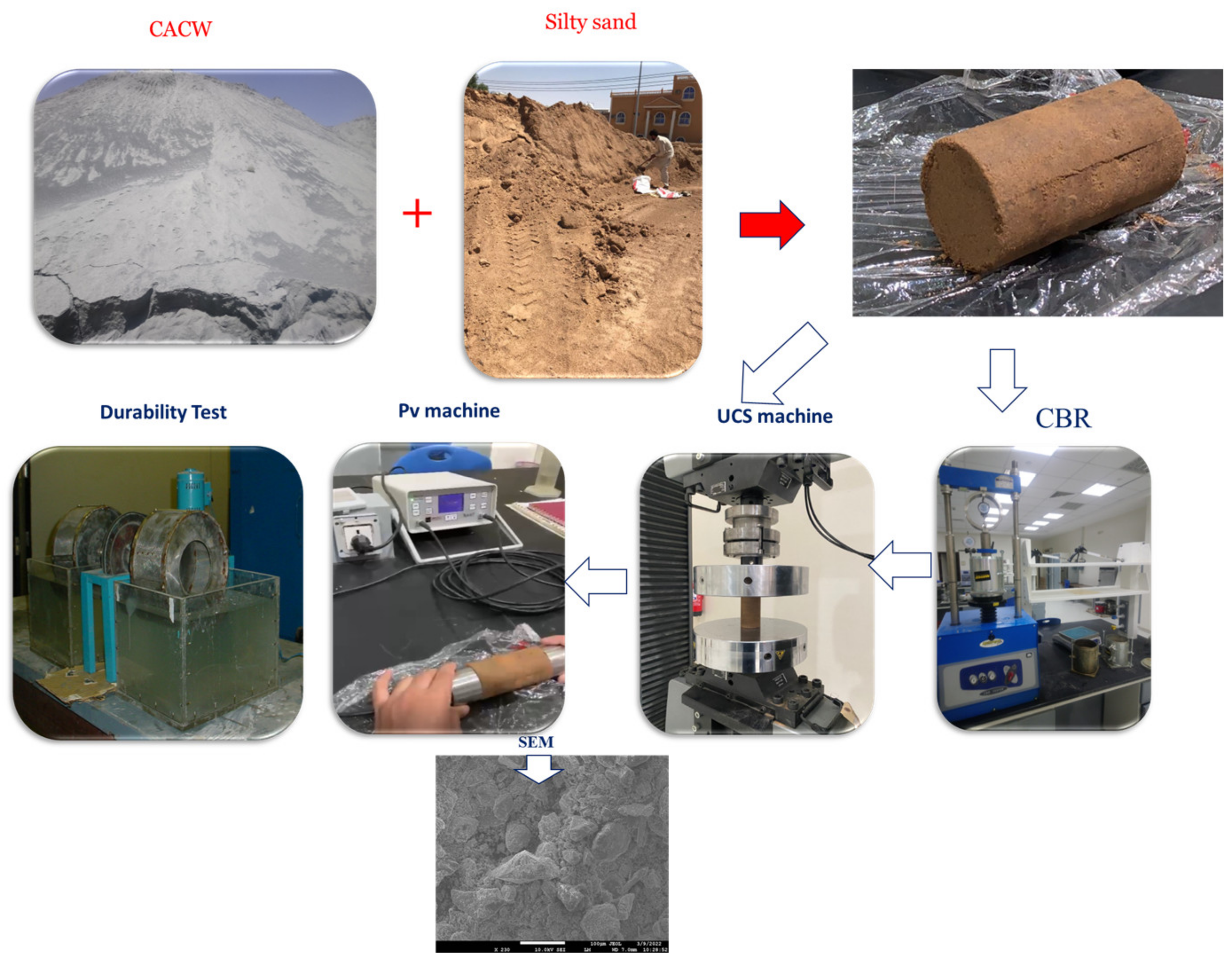
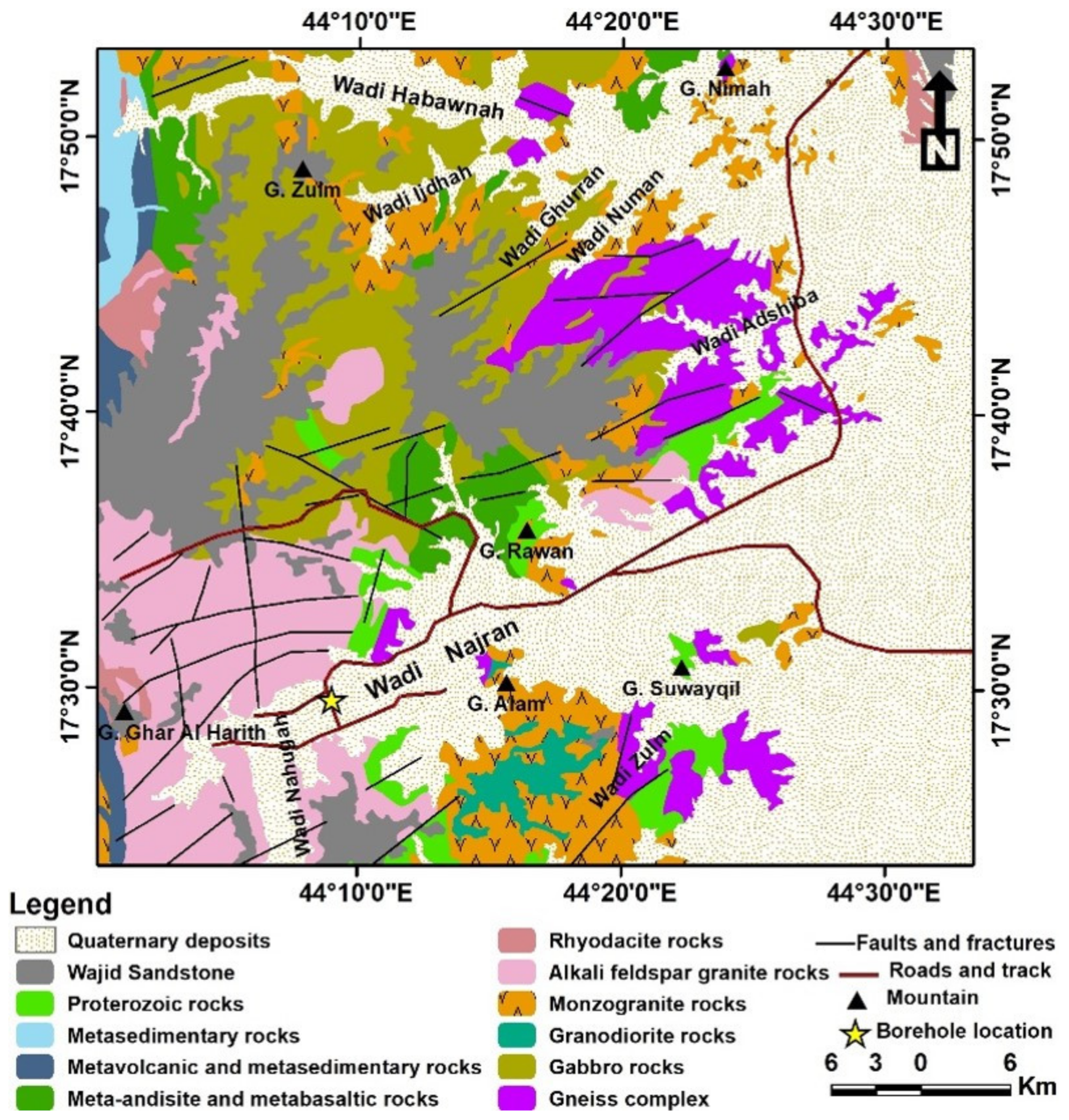
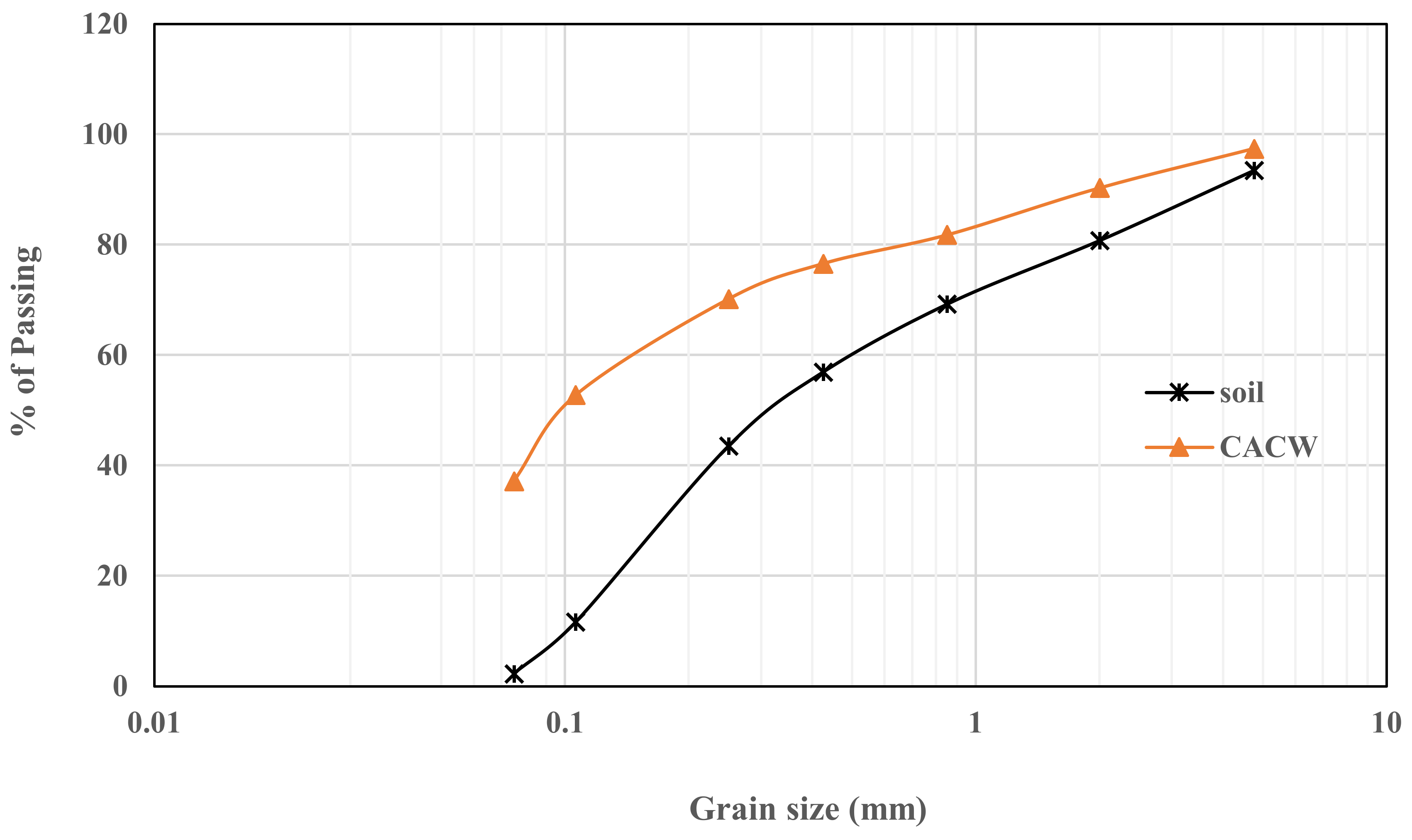
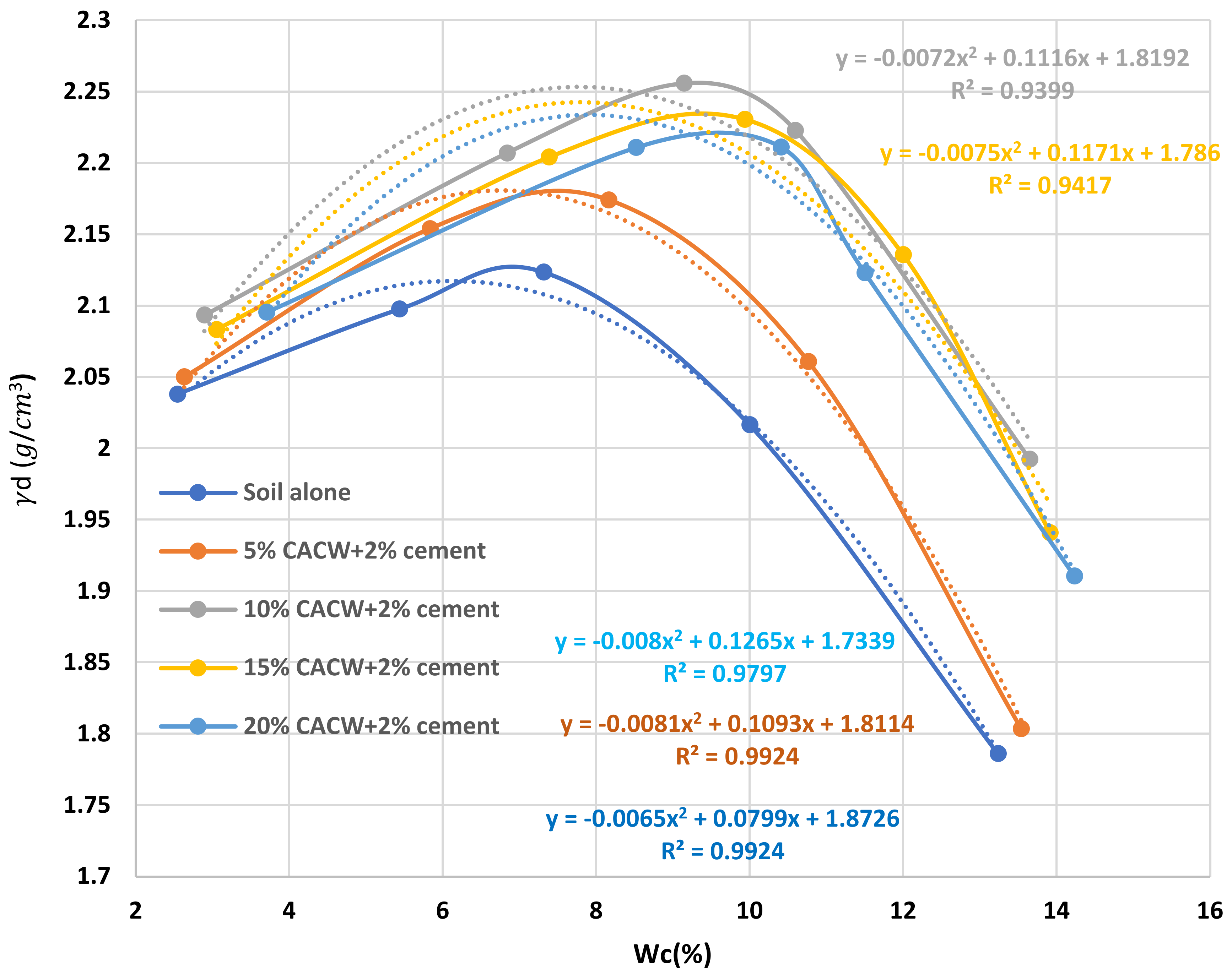

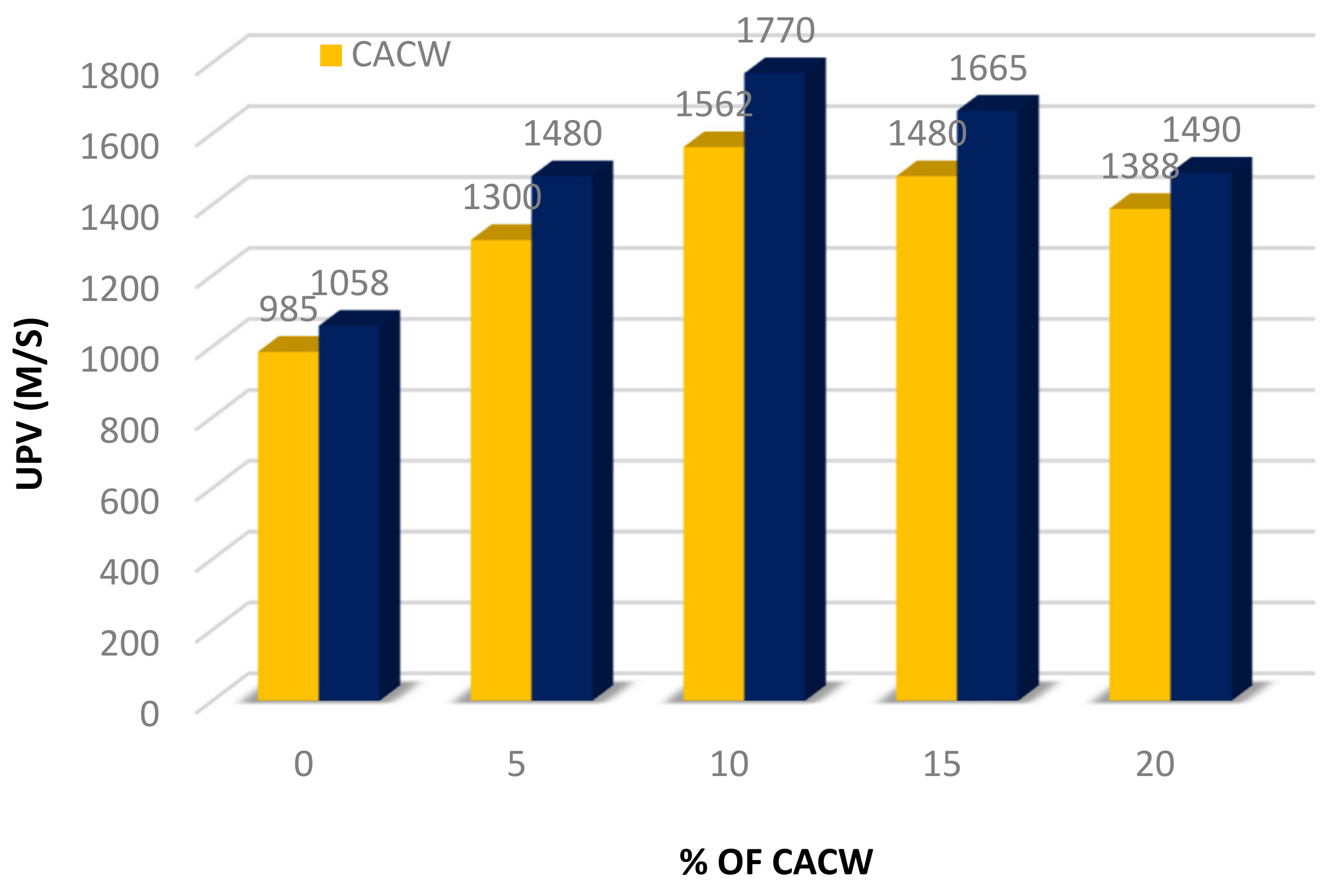
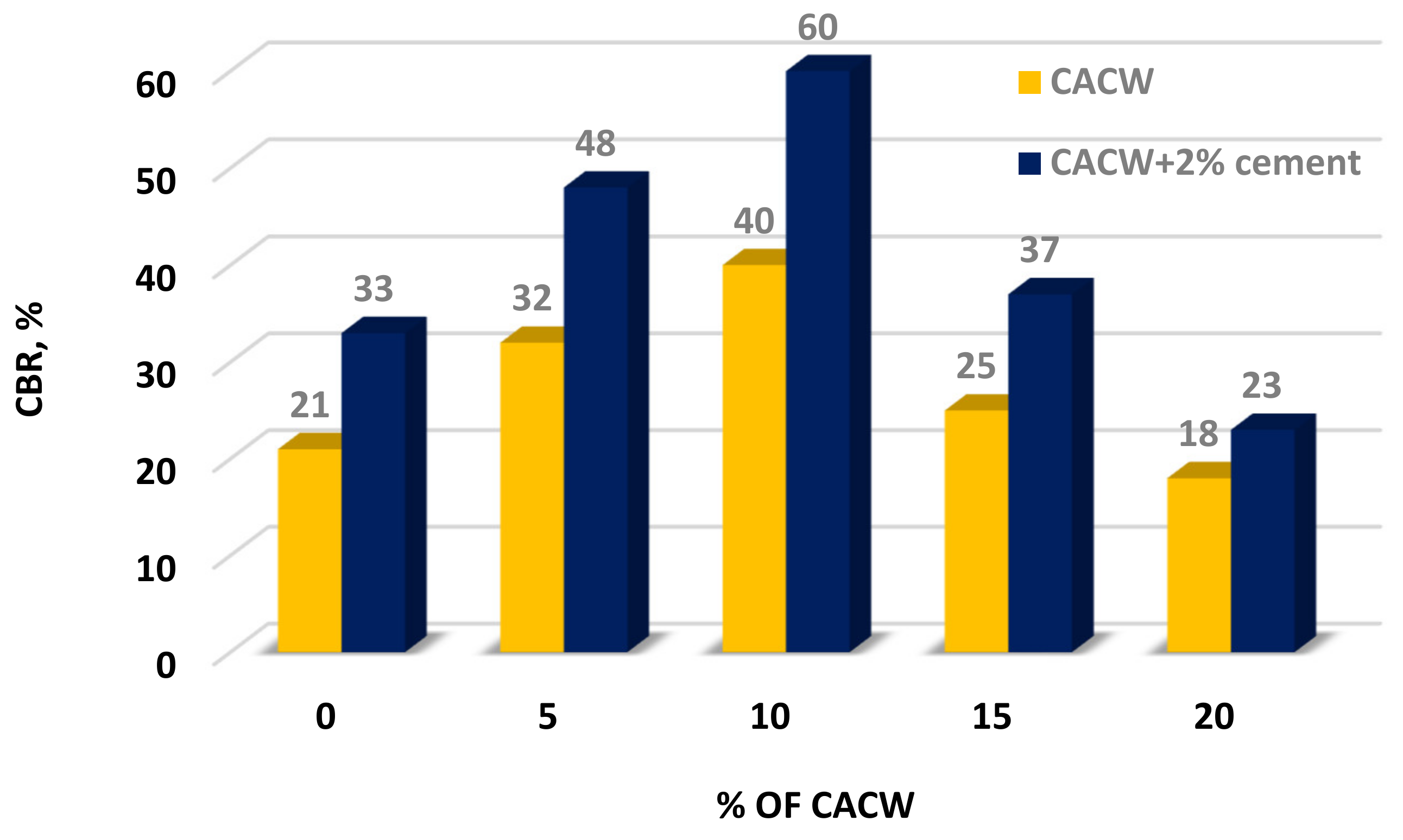
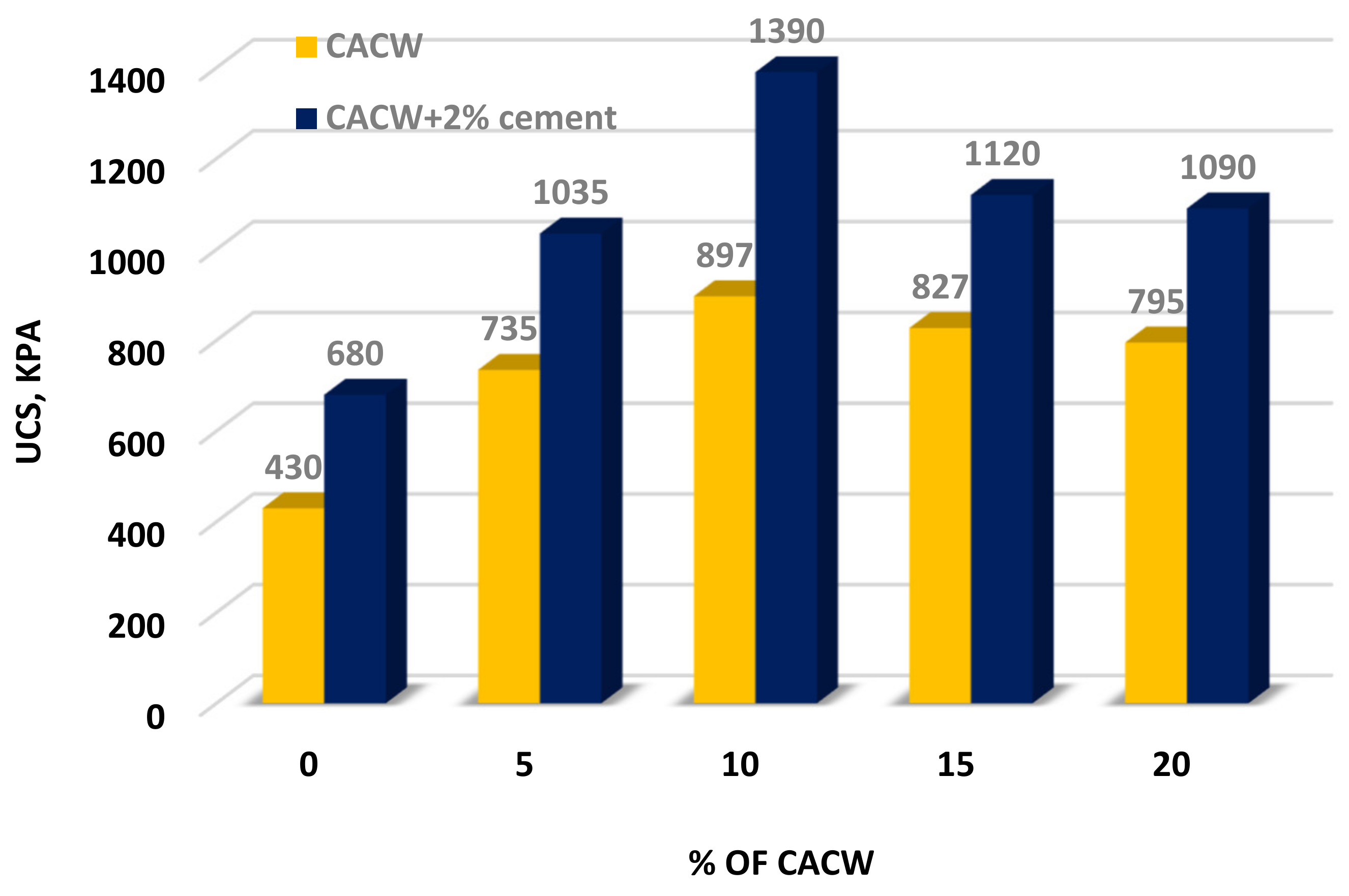
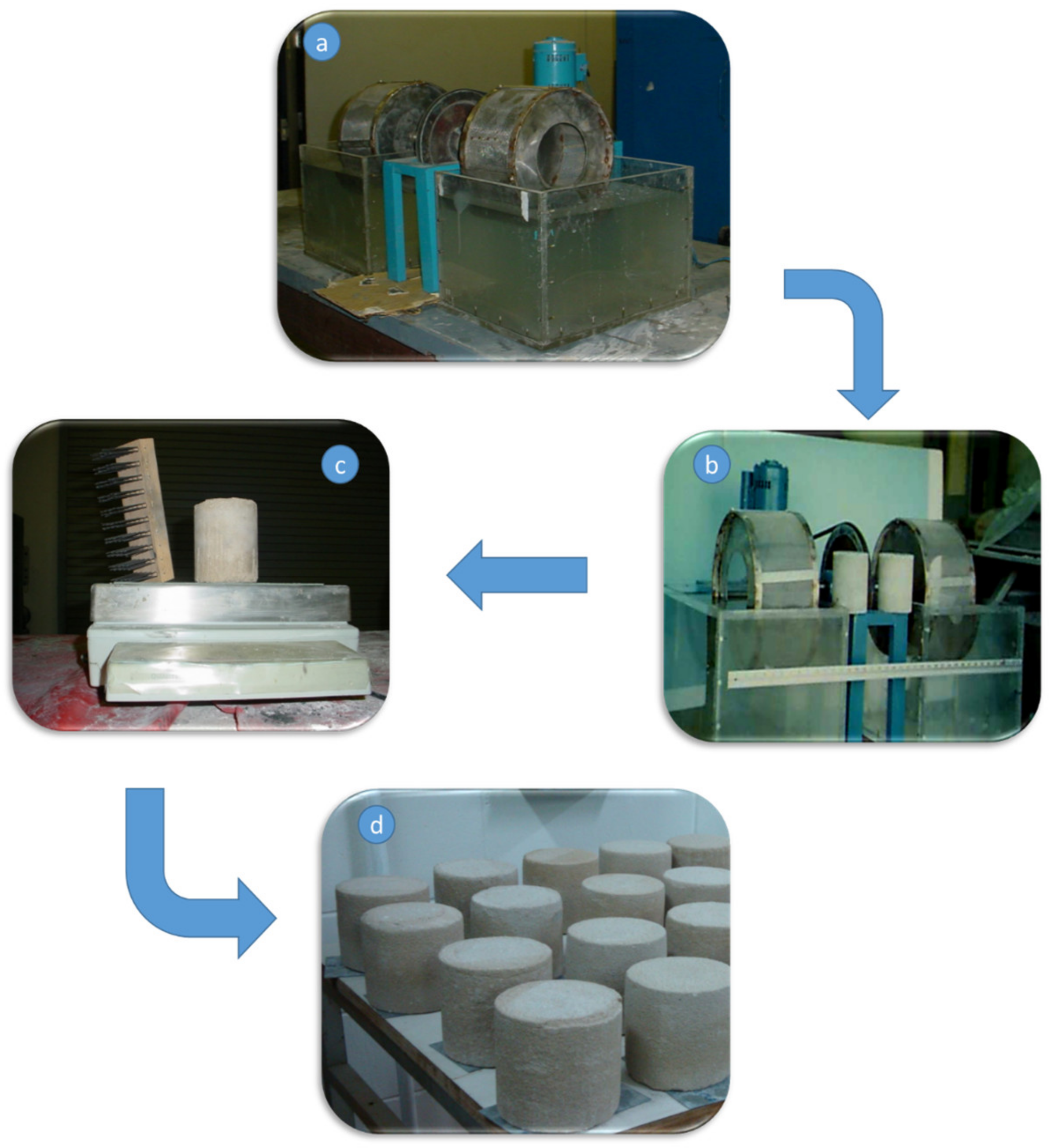
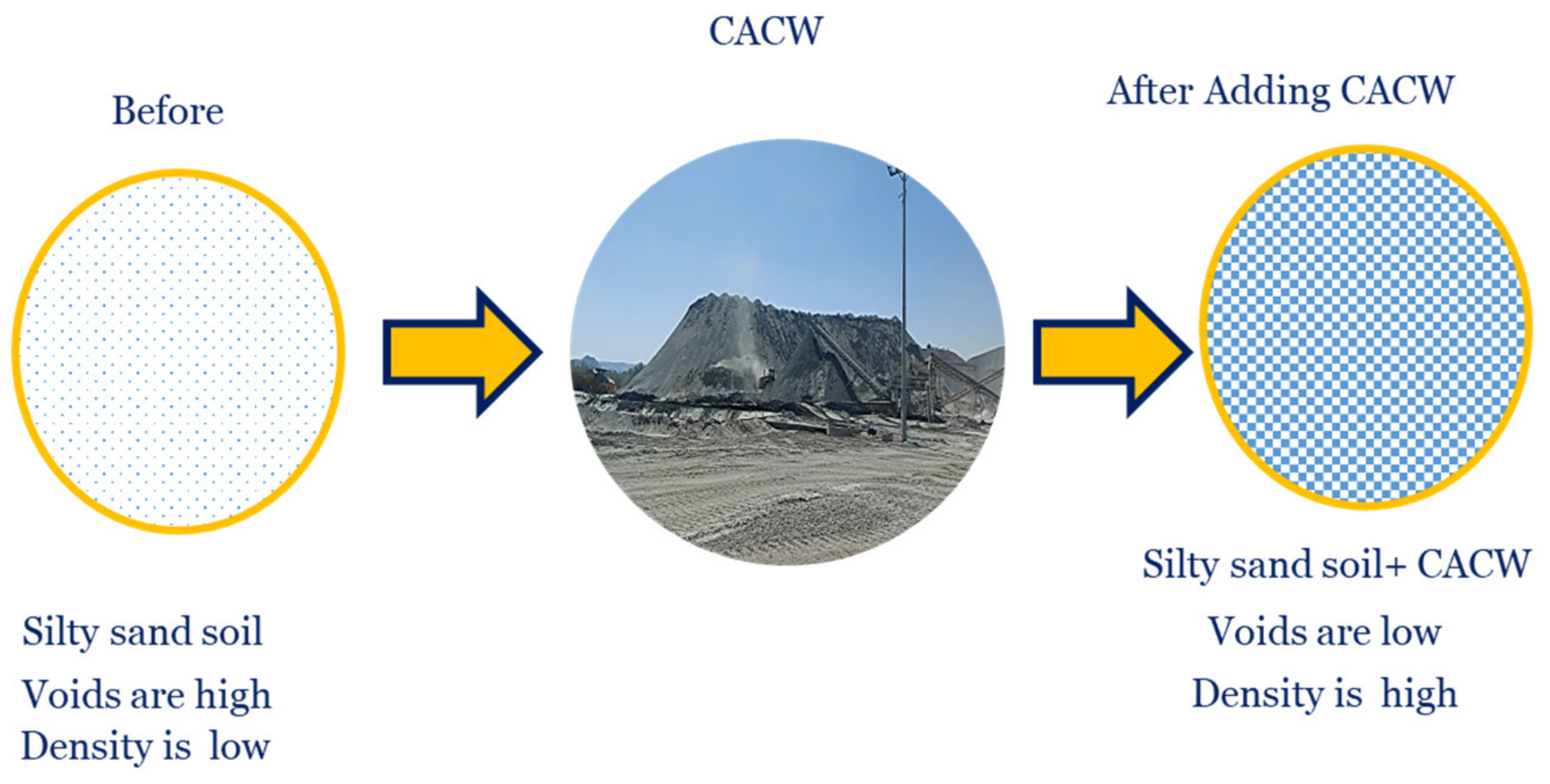
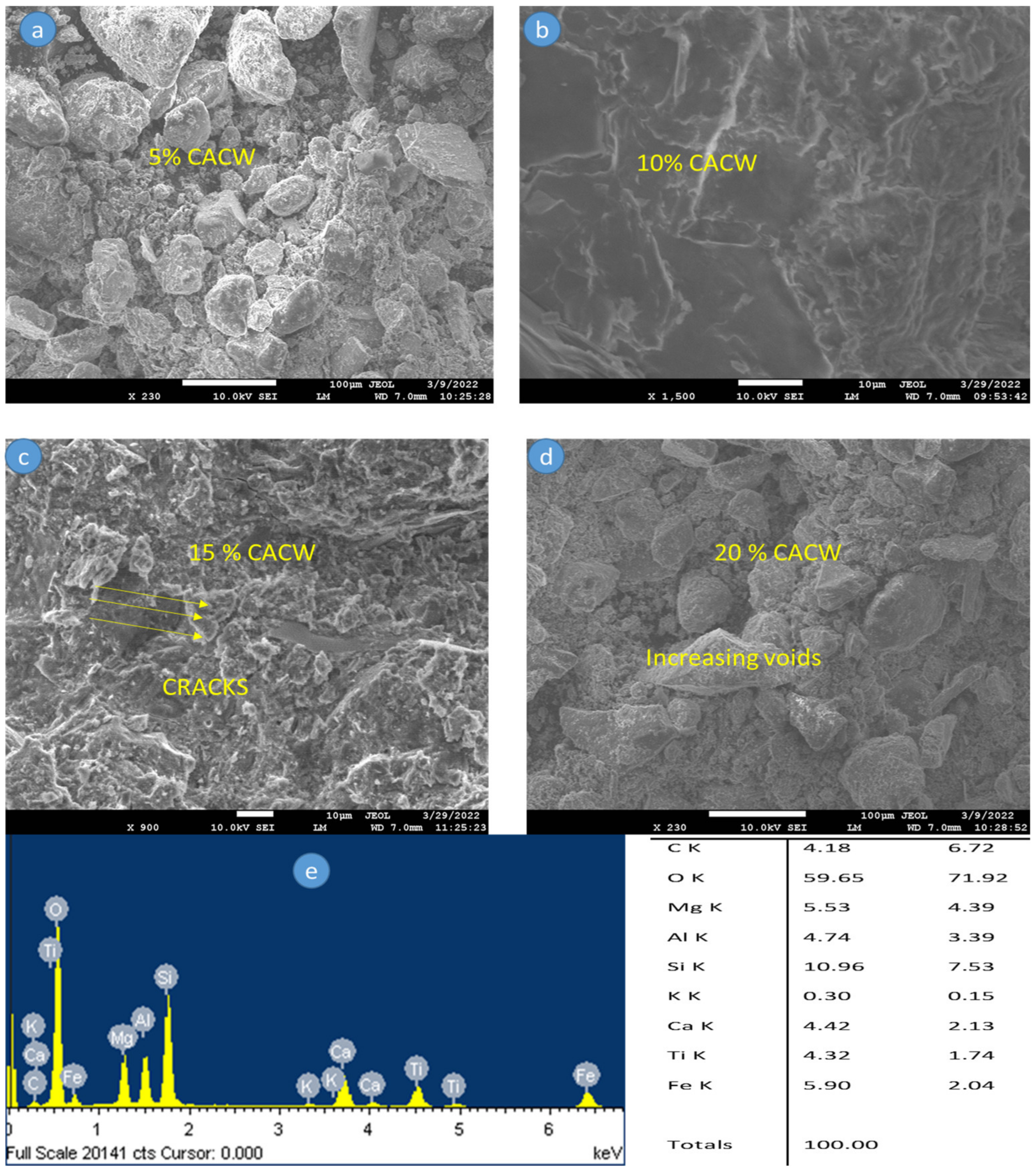
| Element | Composition Range (%) |
|---|---|
| SiO2 | 45–77 |
| Al2O3 | 15–20 |
| CaO | 3–15 |
| Fe2O3 | 6–16 |
| K2O | 3–5 |
| MgO | 1–4 |
| Na2O | 0–3 |
| P2O3 | 0–0.04 |
| TiO2 | 0–2.33 |
| % CACW | 2% C + CACW | |
|---|---|---|
| Mean | 736.8 | 1063 |
| Variance | 32,829.2 | 64,595 |
| Observations | 5 | 5 |
| Pearson Correlation | 0.959028 | |
| Hypothesized Mean Difference | 0 | |
| df | 4 | |
| t Stat | −7.64721 | |
| P (T <= t) one-tail | 0.000786 | |
| t Critical one-tail | 2.131847 | |
| P (T <= t) two-tail | 0.001571 | |
| t Critical two-tail | 2.776445 | |
| Standard Durability of Soil + 10% CACW + 2% C | Slake Durability of Soil + 10% CACW + 2% C | |
|---|---|---|
| Mean | 8.333333 | 10 |
| Variance | 1.166667 | 0.9 |
| Observations | 6 | 6 |
| Pearson Correlation | 0.634335 | |
| Hypothesized Mean Difference | 0 | |
| df | 5 | |
| t Stat | −4.66252 | |
| P (T <= t) one-tail | 0.00276 | |
| t Critical one-tail | 2.015048 | |
| P (T <= t) two-tail | 0.00552 | |
| t Critical two-tail | 2.570582 |
Disclaimer/Publisher’s Note: The statements, opinions and data contained in all publications are solely those of the individual author(s) and contributor(s) and not of MDPI and/or the editor(s). MDPI and/or the editor(s) disclaim responsibility for any injury to people or property resulting from any ideas, methods, instructions or products referred to in the content. |
© 2023 by the authors. Licensee MDPI, Basel, Switzerland. This article is an open access article distributed under the terms and conditions of the Creative Commons Attribution (CC BY) license (https://creativecommons.org/licenses/by/4.0/).
Share and Cite
Abdullah, G.M.S.; Abd El Aal, A.; Al Saiari, M.; Radwan, A.E. Sustainable Impact of Coarse Aggregate Crushing Waste (CACW) in Decreasing Carbon Footprint and Enhancing Geotechnical Properties of Silty Sand Soil. Appl. Sci. 2023, 13, 10930. https://doi.org/10.3390/app131910930
Abdullah GMS, Abd El Aal A, Al Saiari M, Radwan AE. Sustainable Impact of Coarse Aggregate Crushing Waste (CACW) in Decreasing Carbon Footprint and Enhancing Geotechnical Properties of Silty Sand Soil. Applied Sciences. 2023; 13(19):10930. https://doi.org/10.3390/app131910930
Chicago/Turabian StyleAbdullah, Gamil M. S., Ahmed Abd El Aal, Mabkhoot Al Saiari, and Ahmed E. Radwan. 2023. "Sustainable Impact of Coarse Aggregate Crushing Waste (CACW) in Decreasing Carbon Footprint and Enhancing Geotechnical Properties of Silty Sand Soil" Applied Sciences 13, no. 19: 10930. https://doi.org/10.3390/app131910930
APA StyleAbdullah, G. M. S., Abd El Aal, A., Al Saiari, M., & Radwan, A. E. (2023). Sustainable Impact of Coarse Aggregate Crushing Waste (CACW) in Decreasing Carbon Footprint and Enhancing Geotechnical Properties of Silty Sand Soil. Applied Sciences, 13(19), 10930. https://doi.org/10.3390/app131910930








